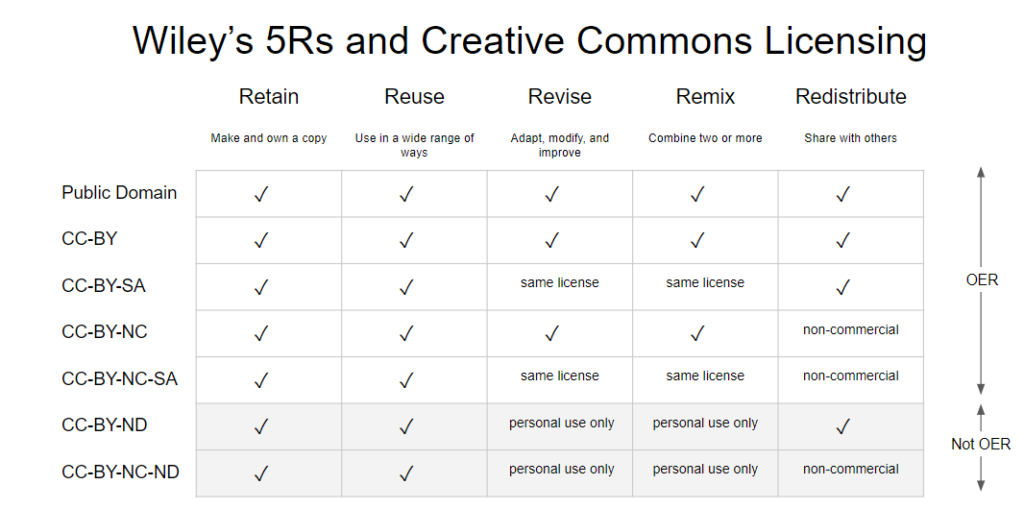Creative Commons Licences
All OER are made available under some type of open license, a set of authorized permissions from the rights-holder of a work for any and all users. The most popular of these licenses are Creative Commons (CC) licenses, customizable copyright licenses that allow others to reuse, adapt, and re-publish content with few or no restrictions. CC licenses allow creators to explain in plain language how their works can be used by others. If you locate a work with a CC license, you can easily determine how you can incorporate the work into your course. If you assign an open license to your work, you allow any user to exercise the rights allowed under the license, and cannot restrict reuse by certain individuals or parties without changing the license itself.

The Four Components of Creative Commons Licenses
| Attribution (BY) Proper attribution must be given to the original creator of the work whenever a portion of their work is reused or adapted. This includes a link to the original work, information about the author, and information about the original work’s license. | |
| Share-Alike (SA) Iterations of the original work must be made available under the same license terms. | |
| Non-Commercial (NC) The work cannot be sold at a profit or used for commercial means such as for-profit advertising. Copies of the work can be purchased in print and given away or sold at cost. | |
| No Derivatives (ND) The work cannot be altered or “remixed.” Only identical copies of the work can be redistributed without additional permission from the creator. |
The four components, or elements, of Creative Commons Licenses are expressed using the icons above. These elements can be mixed and matched to create a total of six Creative Commons licenses. [1] These licenses are often expressed in graphic form using CC buttons. [2]
The Four “Open” CC Licenses
There are strengths and weaknesses to each Creative Commons license you might apply to your OER. To help you make an informed decision, a short description of each license that can be applied to OER is provided below.
Click the ‘info’ button for more information.
You can learn more about the individual CC licenses on the Creative Commons website.
Choosing a Licence for Your Work
Choosing a CC license can be confusing at first, but the online Choose a License tool from Creative Commons can help. This tool generates a license based on which rights you want to retain and which you would like to give to users. For example, if you want to share your work and allow others to adapt it, but you do not want others to be able to sell your work, you might consider using the CC-BY-NC license.
Before you choose a license, keep in mind that an OER should be able to exercise all the 5 Rs of open content we discussed in the previous chapter. Not all of the CC licenses meet this definition. Specifically, the CC-BY-ND and CC-BY-NC-ND licenses do not allow revising or remixing content, two of the most significant freedoms of OER for many educators.

Implementing a CC Licence
Creative Commons has an online Marking Guide that demonstrates how to add your chosen CC license on different types of media. Making your license obvious on whatever item you are sharing is an important part of the dissemination process for OER: otherwise, users won’t know what license you’ve chosen! No matter the format, there are some standards you can follow:
- Make it clear
- Make it visible
- Provide links (to the license and the work)
Dig Deeper: How comfortable are you making your work “open”? After reviewing this section and the Choosing and Applying a CC License chapter in the Creative Commons Certificate Course, reflect on the following questions[4]:
-
- Am I OK with someone using my work without attribution or is it important I get credit?
- Am I OK with other people copying and distributing my content without asking my permission?
- What is the definition of “noncommercial” and “commercial” when used in the context of a CC license? Am I OK with “commercial use” of my content? How might this limit the sharing of the work?
- What is the definition of “non derivative” when used in the context of a CC license? Am I OK with other people changing and adapting the content? How might this limit the sharing of the work?
Attribution vs Citation when Using Other’s Work
Although there are different rules for each license, every CC license includes the Attribution component which requires that users provide proper attribution for an original work being shared or adapted. Attribution is a similar process to citing academic works in a paper, but there are some key differences. The following table outlines some of the ways in which citations and attribution are similar and different:
| Citation | Attribution |
|---|---|
| Purpose is academic (e.g. avoiding plagiarism) | Purpose is legal (e.g. following licensing regulations) |
| Does NOT typically include licensing information for the work | Typically includes licensing information for the work |
| Used to quote or paraphrase a limited portion of a work | Used to quote or paraphrase all or a portion of a work |
| Can paraphrase, but cannot typically change the work’s meaning | Can change the work under Fair Dealing or with advance permission (e.g., under most CC licenses) |
| Many citation styles are available (e.g., APA, Chicago, and MLA) |
Attribution statement styles are still emerging, but there are some defined best practices |
| Cited resources are typically placed in a reference list | Attribution statements are typically found near the work used (e.g., below an image) |
One easy way to remember the requirements for attribution is the acronym T.A.S.L.:
- T = Title of work
- A = Author or creator. Link to a page with their contact information, when possible.
- S = Source. Where can you find the original work?
- L = License. This can be expressed using the abbreviated form (e.g., CC-BY 4.0) and then linked to the full statement.
If the final work is digital, each of these elements can be linked to the original source to provide additional information. If the final work is in print or is an audio/visual file, consider posting the attribution information in a separate online page or mentioning the attribution as part of the credits within the media itself.
In this chapter, we have discussed how Creative Commons licenses work and how you can use these licenses for publishing or sharing open content. In the next chapter, we’ll explore how you can find existing OER to use in your course.
Footnotes
- The No Derivatives and Share Alike components are incompatible and cannot be combined under one licence. ↵
- All icons and buttons found within this and subsequent chapters are created by Creative Commons under a CC-BY 4.0 Licence. ↵
- TheOGRepository. (2012, Sept 5). Creating OER and combining licenses [YouTube video]. Retrieved from https://www.youtube.com/watch?v=Hkz4q2yuQU8 ↵
- Adapted from the Which Creative Commons Licence is Right for Me? fact sheet by Creative Commons Australia, used under a CC BY 2.5 Licence. ↵

